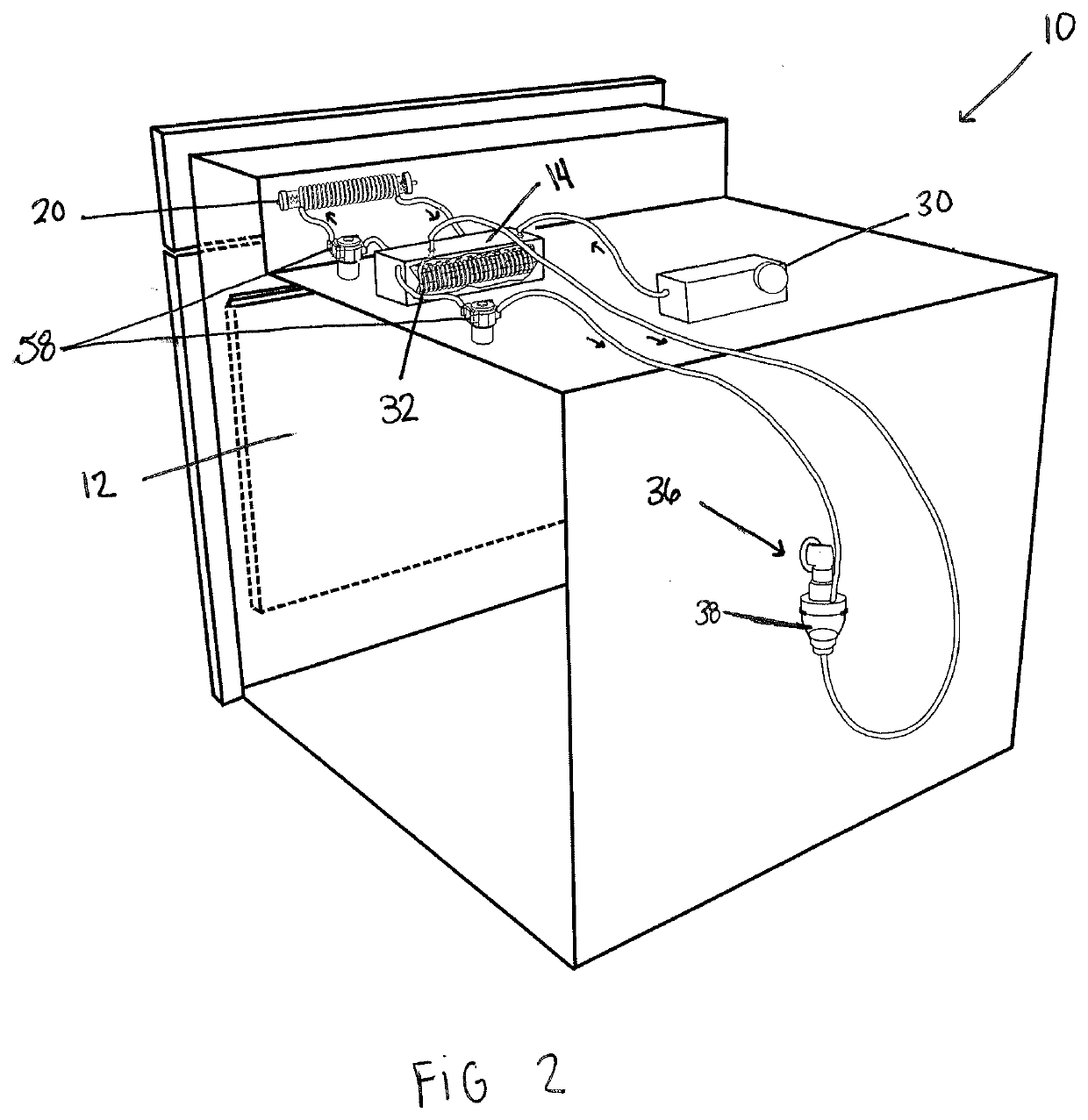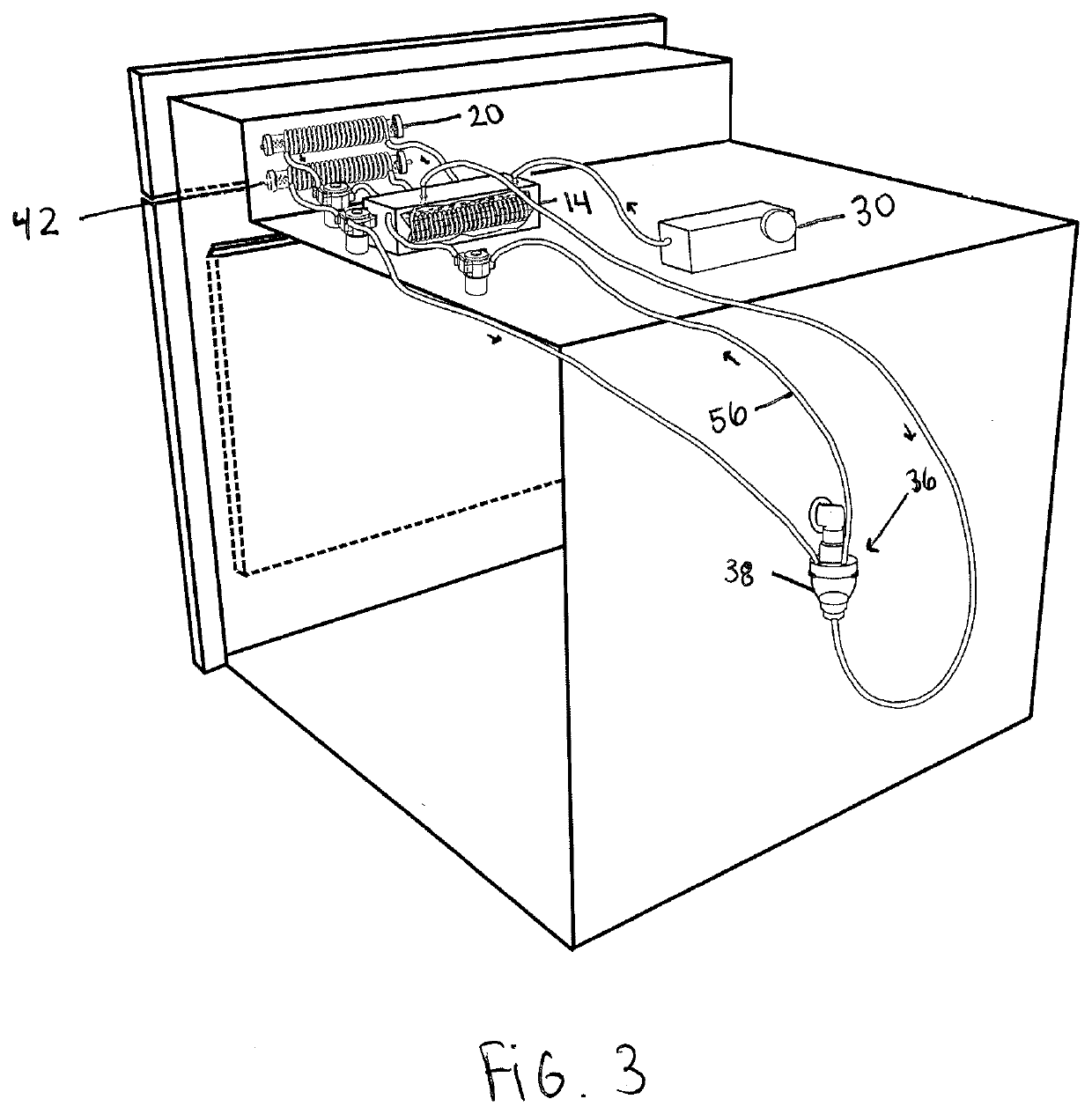Process and apparatus for cooking utilizing nebulized water particles and air
a technology of nebulized water particles and cooking process, which is applied in the field of ovens, can solve the problems of affecting the appearance of cooked food, the use of dry heat ovens, and the loss of nutritional elements and vitamins
- Summary
- Abstract
- Description
- Claims
- Application Information
AI Technical Summary
Benefits of technology
Problems solved by technology
Method used
Image
Examples
first embodiment
[0025]In the first embodiment shown in FIG. 2, after or as the water in the reservoir (14) is recirculating through the water heater coil (20), air is transferred through an air heater coil (32) that is submerged within the water of the reservoir. In this embodiment, the air is piped through the air heater coil, but other embodiments include alternative means of transferring the air, such as a pump. When the water in the reservoir is heated to the desired end point temperature, the air heater coil, which is made of a heat inducting material, such as copper, necessarily heats to the specific desired end temperature of the water in the reservoir. In this embodiment, the air heater comprises a coil, which is beneficial as it heats the air most efficiently when run through the coil. However, the air heater can be any shape or form and made of any material. Accordingly, when air is piped through the air heater coil, the air is heated to the desired end temperature initially selected by a...
second embodiment
[0028]In the oven (10), as shown in FIG. 3, the heated water from the reservoir (14) is pumped through an additional water heater coil (42) on its way to the nebulizer (36). This additional water heater coil can act as a secondary heat source for the heated water to ensure that the heated water reaches the nebulizer at the desired end temperature. The second water heater coil also ensures that the heated water has not lost its temperature as a result of its movement to the nebulizer (36). The second water heater is used as a “trimming” heater, fine-tuning the temperature of the pre-heated water in the reservoir.
[0029]In the first embodiment, as shown in FIG. 2, the heated water is nebulized into heated water particles within the nebulizer (36) using conventional nebulizer techniques. The nebulizer can be any form of nebulizer, such as a Philips Respironics HS 860 SideStream nebulizer, which are disposable and made of a plastic. These nebulizers have a unique five-hole design and a v...
third embodiment
[0035]In a third embodiment, as shown in FIG. 4, the oven (10) includes a chilling or refrigeration element, wherein either independently, or in addition to heated air and heated water being pumped to the nebulizer (36), chilled air and water is delivered to the nebulizer. In this embodiment, the air is piped through the air heater coil, but other embodiments include alternative means of transferring the air, such as a pump.
[0036]In this third embodiment, as shown in FIG. 4, there is a chilled reservoir (60) that is located outside a cooking chamber (12) of the oven (10). This chilled reservoir contains water that is pumped into the chilled reservoir at a set temperature, for instance from a cold-water tank. If the water is manually inserted or pumped from a municipal water source into the chilled reservoir, a Peltier thermoelectric block (70) is located underneath the chilled reservoir. For the refrigeration embodiment, in order to meet USDA food safety guidelines, the water temper...
PUM
 Login to View More
Login to View More Abstract
Description
Claims
Application Information
 Login to View More
Login to View More - R&D
- Intellectual Property
- Life Sciences
- Materials
- Tech Scout
- Unparalleled Data Quality
- Higher Quality Content
- 60% Fewer Hallucinations
Browse by: Latest US Patents, China's latest patents, Technical Efficacy Thesaurus, Application Domain, Technology Topic, Popular Technical Reports.
© 2025 PatSnap. All rights reserved.Legal|Privacy policy|Modern Slavery Act Transparency Statement|Sitemap|About US| Contact US: help@patsnap.com



